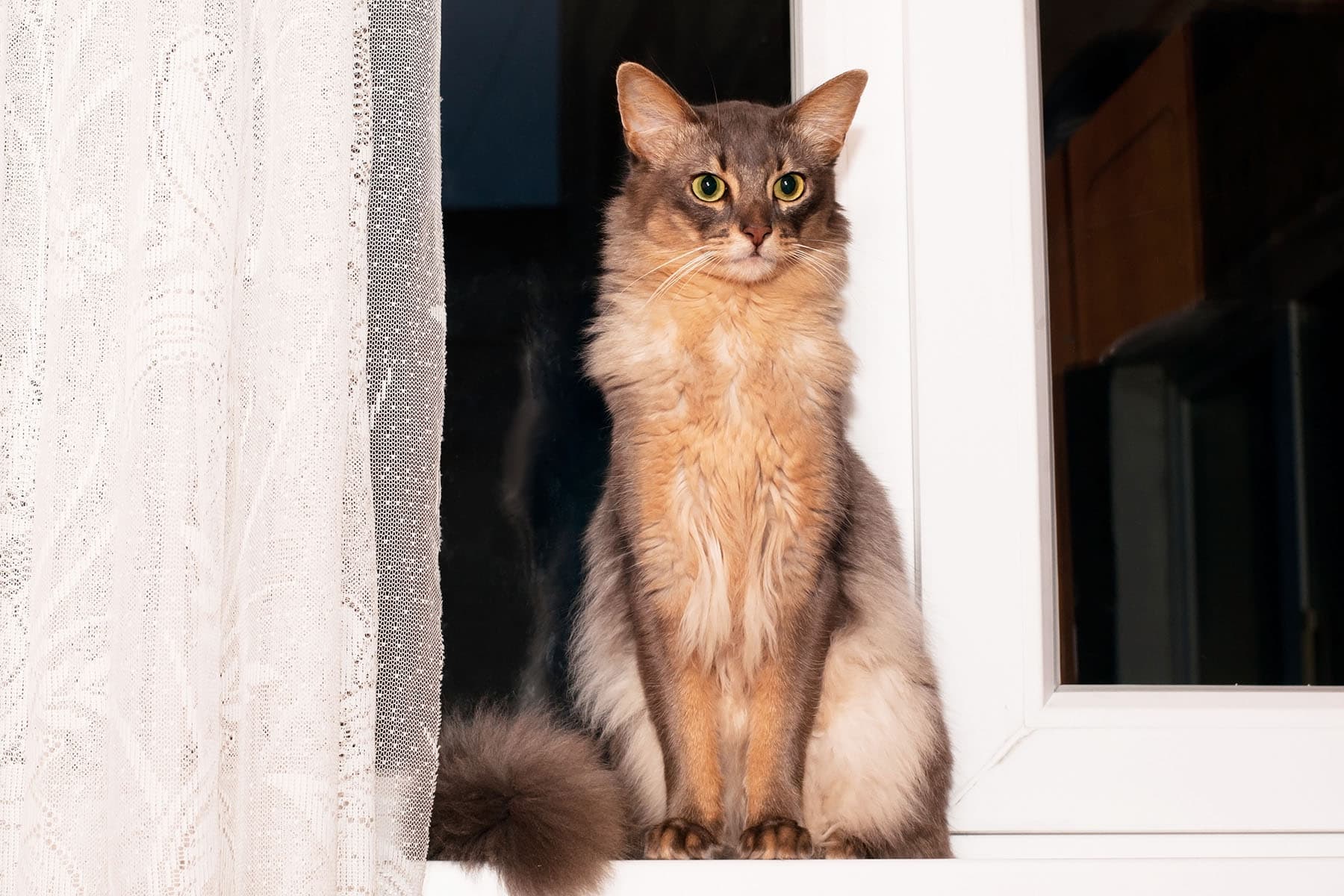
Somali cats — often called "the cat with a smiling face" — are known for their pleasing personality. They're as charming as they are beautiful, which makes them very easy to love. Many refer to them as natural clowns since their playful and lively antics always make people laugh. This is why they're also popular in show rings. If you're looking for an entertaining and intelligent cat that'll shower you with affection, then the Somali breed may be the right choice for you.
Characteristics of Somali Cats
Physical characteristics. Somalis are stunning cats with lithe, muscular, well-proportioned bodies. With an expressive face, striking facial markings, and large eyes and ears, they're often compared to a small mountain lion or cougar. One of the most unique characteristics of Somali cats is their long and tapering bushy tail, which has earned them the nickname "fox cat".
Most of their body is covered with a long and flowing medium-length coat. But the tufts of hair between their toes are longer. You can easily recognize these cats by their agouti (ticked) fur, where each hair has numerous bands of color.
The coats of this breed come in 28 different colors, which include sorrel (a rich copper), lilac, cream, chocolate, and silver, as well as many tortie shades. However, the Cat Fanciers' Association (CFA) only recognizes Somalis with red, ruddy, fawn, and blue coat colors.
Regarding the size of Somali cats, the males are bigger and heavier than the females. Adult males have medium-to-large bodies and weigh around 8 to 10 pounds. Meanwhile, adult females have small-to-medium bodies and weigh anywhere between 6 and 8 pounds.
Temperament: The personality of Somali cats is often described as social and friendly. They're loyal, affectionate, and highly interested in whatever their owners are doing. You should consider it normal if your Somali keeps following you around and tries to talk to you in their own ways. These cats are also very active by nature and are always looking for things to do.
Most people love having Somalis as pets due to their highly entertaining habits. Everything they do, from the way they walk to the way they play with toys, they do in such a funny way that you'll never be bored. As their owner, you should also be aware of their curious personalities. They are such nosy animals that many people call them "preposition cats" since they try to go below, under, above, over, between, into, and through every corner of their owner's house.
Caring for Somali Cats
Grooming. To keep your Somali's coat free of tangles and mats, brush it once or twice a week. The fact that this breed likes being groomed may make the task easier. You can also stroke their coat with your hands or polish them with a silk cloth to keep them soft and silky. There's no need to bathe your cat unless they step into something dirty.
Make sure to clip their claws at least once every two weeks. Since Somali cats are prone to gum diseases like gingivitis, start brushing your pet's teeth using cat-specific toothpaste from a very young age. Taking your cat to the vet for dental cleanings once in a while may also help keep gum and tooth diseases at bay.
Exercise. Thanks to their well-muscled bodies, Somali cats can stay active for a long time. This is why you may need to exercise them more than other cat breeds. Playing with your cat many times a day will give them an outlet for their excess energy and help you bond with them better. Since they have agile minds, you can also include cat toys in your games to give them mental stimulation.
Another great way to exercise your Somali is by taking them out on leashed walks. Doing so will keep them highly engaged, as these cats love playing outside with their owners.
Training. It's easy to train your Somali. These cats are intelligent and always eager to try new activities. With proper command training, you can teach them to "stay" and "sit" and even play fetch. Just keep in mind that they learn best using positive reinforcement techniques. So, use treats and rewards to motivate them.
Since Somali cats are highly energetic, regular training sessions can have dual benefits for them. They can help these cats learn tricks as well as burn off their excess energy. Otherwise, if not kept engaged, your Somali may start knocking off objects from the shelf, climbing curtains, or ripping up tissues to entertain themselves.
Diet. Being highly active, Somalis have good appetites. To keep them in shape, you should feed them high-quality cat food two times a day. Make sure their diet has more protein-rich meat-based ingredients than refined grains and fillers, which are less nutritious.
Keep in mind that Somalis tend to overeat when they have easy access to food. To avoid this, make sure you don't free-feed them. To get a clear idea about what you can and can't give your cat, talk to your vet. They would be able to guide you regarding the best food that suits your pet's age and activity levels.
Medical care. Somali cats — especially younger ones — are prone to getting tuberculosis infections. But you can prevent it by taking your cat for regular checkups, getting them vaccinated, and having your vet provide them proper preventive treatments.
Cats of this breed can also become infested with lice, fleas, and intestinal worms. To reduce the risk of these problems, talk to your vet, who can suggest suitable preventatives or antiparasitic drugs for your pet.
Health Problems to Watch for With Somali Cats
The average lifespan of Somali cats is around 12 to 14 years. But since the breed is inherently healthy and strong, some cats can even live beyond 19 years with proper care. However, like other cat breeds, they're prone to some specific hereditary health conditions. So, before buying a kitten, confirm with your breeder if the litter has been tested for these genetic problems:
- Patellar luxation: In this condition, your cat's knee cap (patella) slips out of place. This can cause pain, difficulty in moving, and even arthritis if left untreated.
- Amyloidosis: This is a kidney or liver problem that causes amyloid protein deposits to build up in your pet's organs. Cats with this condition have high blood pressure. In extreme cases, it can also lead to tissue damage and organ failure.
- Progressive retinal atrophy (PRA): This refers to a group of genetic conditions that causes the cells in your cat's retina (the innermost light-sensitive tissue in the eye) to deteriorate over time. If not treated, it can eventually lead to blindness.
- Pyruvate kinase deficiency (PKD): Cats with PKD lack pyruvate kinase — an important enzyme needed by the red blood cells. It can cause your Somali to develop anemia and a host of other symptoms, like fatigue, weight loss, and jaundice.
Special Considerations for Somali Cats
Somali cats love playing and spending time with humans. If not kept engaged, they can get bored. So, you should only plan to get them as pets if you stay at home most of the time or have other pets to keep them company. Despite being social, they may not get along well with large cats since they can compete with them for attention.
Keep in mind that just because Somalis have a friendly nature, it doesn't mean that they will want to be held by you. These cats may cuddle with you on the bed or climb on your lap, but always on their own terms.
Due to their curious and playful nature, Somalis can wander off while exercising outside. To avoid this, put a leash on them whenever you take them outdoors. If you let them play by themselves, make sure they do so within a well-fenced yard or a secure garden. If that's not possible, you can just keep them inside. Just make sure to provide them with scratching posts and different kinds of toys so that they stay entertained.
History of Somali Cats
While there's some mystery regarding the origin of the Somali cats, there's no doubt about their genetic makeup. Somalis have now been universally accepted as the long-haired descendants of Abyssinians.
Some experts believe that Somalis came into existence when a few Abyssinian cats were crossbred with an unknown breed of long-haired cats during the early 1900s. This introduced a special "long-haired" gene into the Abyssinian population, which is how a new Somali breed appeared in their litter.
Others believe that the Abyssinian ancestors of the first Somali cats were brought before the world by a British breeder called Janet Robertson. In the 1940s, she exported some Abyssinian kittens to North America, New Zealand, and Australia. Some of their descendants gave birth to cats with fuzzy or long coats. These cats were later identified as Somali cats.
Most historians believe that breeders only started actively developing the Somali breed once these cats gained recognition in pet shows. For example, a Canadian breeder named Mary Mailing entered one of the long-haired Abyssinians into a local pet show. The show's judge, Ken McGill, liked the cat so much that he started a breeding program with them. One of McGill's cats, named Mayling Tutsuta, became the first Somali cat to be recognized by a fancier organization.
By the early 1980s, the Somali breed was fully accepted by all North American cat registries. In the same decade, these cats became accepted in Europe. Today, all important cat registries in the world recognize this unique breed.
